Bennemann K.H., Ketterson J.B. Superconductivity: Volume 1: Conventional and Unconventional Superconductors; Volume 2: Novel Superconductors
Подождите немного. Документ загружается.


13 Unconventional Superconductivity in Novel Materials 721
Fig. 13.85. Conduction electron spin susceptibility in the
superconducting state
s
for an s-wave superconductor
(V
3
Si) and Sr
2
RuO
4
, based on spin polarized neutron scat-
tering measurements [567]. In (a), the original work of
Shull and Wedgewood [568] is confirmed and the data are
described well by the Yosida function. In (b),thetempera-
ture independence of
x
for Sr
2
RuO
4
is in marked contrast
to that expected if Sr
2
RuO
4
had singlet spin pairing, af-
ter [569]
ing can increase
s
(T) for spin-singlet pairing, it is
not expected to be strong enough in Sr
2
RuO
4
to in-
crease
s
(T)to
n
(T) [570].The behavior of
s
(T) for
the s-wave superconductor V
3
Si and the unconven-
tional superconductor Sr
2
RuO
4
,basedonspinpo-
Fig. 13.86. Spin triplet superconducting states correspond-
ing to d(k)=ˆz(k
x
+ ik
y
)(left)andd(k)=ˆxk
x
+ ˆyk
y
(right)
The ˆz(k
x
+ ik
y
) state has an angular momentum along the
z-axis (thick arrow) and spins perpendicular in the plane
(thin arrows)Theˆxk
x
+ ˆyk
y
state has vanishing total an-
gular momentum because the orbital angular momentum
is compensated by the spins of the Cooper pair. Experi-
ments indicate that the superconducting phase in Sr
2
RuO
4
isofthetypeshownintheleft panel; i.e.,a state with finite
angular momentum, after [570]
larized neutron scattering measurements of Duffy
et al. [567], are shown in Fig. 13.85. Other evidence
for unconventional superconductivity in Sr
2
RuO
4
is
the extreme sensitivity of the superconductivity to
nonmagnetic impurities; T
c
vanishes for Al or Si im-
purity concentrations corresponding to a mean free
path that is comparable to the superconducting co-
herence length. One of the most intriguing results
comes from ‹SR measurements on Sr
2
RuO
4
that re-
veal an enhancement in the zero field relaxation rate
in the superconducting state that is consistent with
a superconducting state with broken time reversal
symmetry [322]. A variety of experiments indicate
that the superconducting energy gap has nodes or
very deep minima,although thee form of these nodes
is still uncertain.
The spin-triplet superconducting state that seems
to be favored by experiments on Sr
2
RuO
4
has the
form d(k)=ˆz(k
x
+ ik
y
). This state and another
spin-triplet state are schematically represented in
Fig. 13.86 [570]. The ˆz(k
x
+ ik
y
) state has angular
momentum along the z-axis (thick arrow) and spins
perpendicular in the plane (thin arrows), while the
ˆxk
x
+ ˆyk
y
state has vanishing total angular momen-
tum because the orbital angular momentum is com-
pensated by the spins of the Cooper pair [570]. A
comprehensive review of the normal and supercon-
ducting state properties of Sr
2
RuO
4
and the physics
of spin-triplet pairing can be found in [569].
Quantum spin ladder materials have attracted
much interest [575,576]. These materials consist of

722 M.B. Maple et al.
Table 13.7.(a) Some important classes of cuprate superconductors and the maximum value of
T
c
observed in each class. (b) Examples of the abbreviated names (nicknames) used to denote
cuprate materials
(a)
Material Max. T
c
(K)
La
2−x
M
x
CuO
4
; M = Ba, Sr, Ca, Na ∼ 40
Ln
2−x
M
x
CuO
4−y
;Ln=Pr,Nd,Sm,Eu;M=Ce,Th ∼ 25
YBa
2
Cu
3
O
7−ı
92
LnBa
2
Cu
3
O
7−ı
∼ 95
Ce, Tb do not form phase.
Pr forms phase; neither metallic nor superconducting.
RBa
2
Cu
4
O
8
∼ 80
Bi
2
Sr
2
Ca
n−1
Cu
n
O
2n+4
(n = 1,2,3,4) (n = 3) 110
TlBa
2
Ca
n−1
Cu
n
O
2n+3
(n = 1,2,3,4) (n = 4) 122
Tl
2
Ba
2
Ca
n−1
Cu
n
O
2n+4
(n = 1,2,3,4) (n = 3) 122
HgBa
2
Ca
n−1
Cu
n
O
2n+2
(n = 1,2,3,4) (n = 3) 133
(b)
Material Nickname
YBa
2
Cu
3
O
7−ı
YBCO; YBCO–123; Y–123
Bi
2
Sr
2
Ca
2
Cu
3
O
10
BSCCO; BSCCO–2223; Bi–2223
Tl
2
Ba
2
Ca
2
Cu
3
O
10
TBCCO; TBCCO–2223; Tl–2223
HgBa
2
Ca
2
Cu
3
O
8
HBCCO; HBCCO–1223; Hg–1223
La
1.85
Sr
0.15
CuO
4
LSCO
Nd
1.85
Ce
0.15
CuO
4−y
NCCO
ladders made of AFM chains of S =1/2spinscoupled
by inter-chain AFM bonds. Examples of two-leg lad-
der materials are SrCu
2
O
3
and LaCuO
2.5
;anexample
of a three-leg ladder material is Sr
2
Cu
2
O
5
. Supercon-
ductivity has been discovered in the ladder material
Sr
0.4
Ca
13.6
Cu
24
O
41.84
under pressure with T
c
≈ 12
K at 3 GPa [577]. Interest in quantum spin ladder
materials is partly due to the fact that they are sim-
ple model systems for theories of superconductivity
based on magnetic pairing mechanisms.
Approximately 100 different cuprate materials,
many of which are superconducting, have been dis-
covered since 1986. Several of the more important
high T
c
cuprate superconductors are listed in Table
13.7, along with the maximum values of T
c
observed
in eachclass of materials.Included in the table are ex-
amples of abbreviated designations (nicknames) for
specific cupratematerials whichwe will use through-
out this article (e.g., YBa
2
Cu
3
O
7−ı
=YBCO,YBCO-
123,Y-123).
It is interesting to note that superconductivity
with values of T
c
in the neighborhood of 30–40 K
has been found in several noncuprate materials: the
cubic perovskite Ba
1−x
K
x
BiO
3
(T
c
≈ 30 K) [578,579],
the fcc “buckeyball” compound Rb
3
C
60
(T
c
≈ 29
K) [580, 581], and the compound MgB
2
(T
c
≈ 39
K) [582].
13.5.3 Structure and Charge Carrier Doping
The high T
c
cuprate superconductors have layered
perovskite-like crystal structures which consist of
conducting CuO
2
planes separated by layers com-
prised of other elements, denoted as A, and oxygen,
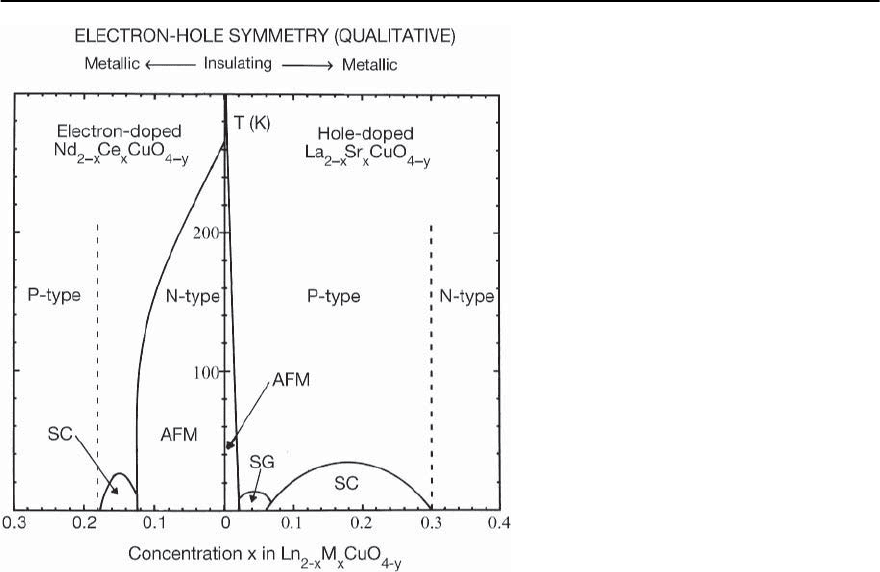
13 Unconventional Superconductivity in Novel Materials 723
Fig. 13.87. Temperature-dopant concentration
(T–x) phase diagram delineating the re-
gions of superconductivity and antiferromag-
netic ordering of the Cu
2+
ions for the
hole-doped La
2−x
Sr
x
CuO
4
and electron-doped
Nd
2−x
Ce
x
CuO
4−y
systems. AFM = antiferro-
magnetic phase, SG = spin-glass phase, and SC
= superconducting phase, after [585]
A
m
O
n
,and,in some cases,layers of Ln ions [583,584].
The mobile charge carriers, which can be electrons
but are usually holes,are generally believed to reside
primarily within the CuO
2
planes. The A
m
O
n
layers
apparently function as charge reservoirs that control
the doping of the CuO
2
planes with charge carri-
ers and as spacers that govern the anisotropy of the
physical properties of the materials.
Many of the cuprates can be doped with charge
carriers and rendered superconducting by substi-
tuting appropriate elements into an AFM insulat-
ing parent compound. For example, substitution of
divalent Sr for trivalent La in the AFM insulator
La
2
CuO
4
dopes the CuO
2
planes with mobile holes
and produces superconductivity in La
2−x
Sr
x
CuO
4
with a maximum T
c
of ∼ 40 K at x ≈ 0.17 [549].
Similarly, substitution of tetravalent Ce for triva-
lent Nd in the AFM insulating compound Nd
2
CuO
4
apparently dopes the CuO
2
planes with electrons,
resulting in superconductivity in Nd
2−x
Ce
x
CuO
4−y
with a maximum T
c
of ∼ 25 K at x ≈ 0.15 for y
≈ 0.02 [556,585]. The temperature T vs x phase di-
agrams for the La
2−x
Sr
x
CuO
4
and Nd
2−x
Ce
x
CuO
4−y
systems are shown in Fig. 13.87 [585].
The Ln
2−x
M
x
CuO
4−y
electron-doped materials
have a tetragonal crystal structure that is similar
to that of the La
2−x
M
x
CuO
4
hole-doped materials,
but without the apical oxygen atoms. The crys-
tal structures of the La
2
CuO
4
and Nd
2
CuO
4
parent
compounds are displayed in Fig. 13.88 [585]. The
La
2−x
Sr
x
CuO
4
and Nd
2−x
Ce
x
CuO
4−y
systems have
one CuO
2
plane per unit cell and are referred to as
single CuO
2
layer compounds. Other superconduct-
ing cuprate systems have more than one CuO
2
plane
per unit cell: LnBa
2
Cu
3
O
7−ı
has two CuO
2
planes
per unit cell (double CuO
2
layer compound), while
Bi
2
Sr
2
Ca
n−1
Cu
n
O
x
has n CuO
2
layers per unit cell (n
CuO
2
layer compound) and can be synthesized by
conventional methods for n =1, 2, or 3.
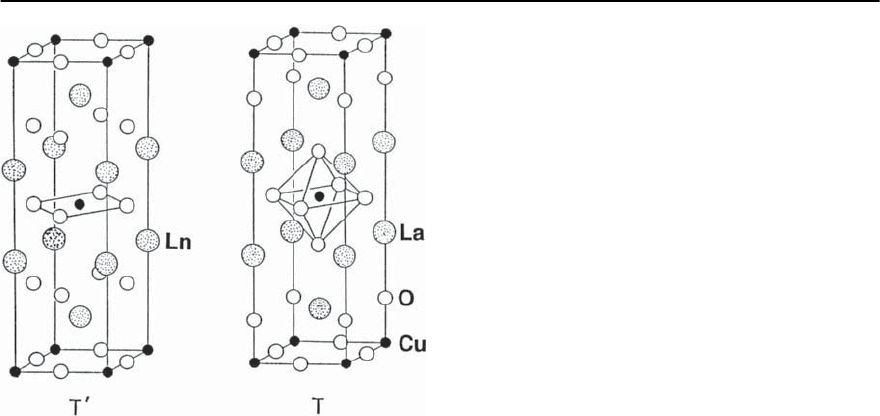
724 M.B. Maple et al.
Fig. 13.88. Crystal structures of La
2
CuO
4
(T-phase) and
Ln
2
CuO
4
(Ln = Pr, Nd, Sm, Eu, Gd; T
-phase) parent com-
pounds, after [585]
13.5.4 Superconducting Properties
Critical Field and Critical Current Density
With values of T
c
in excess of the boiling tempera-
ture of liquid nitrogen (77 K) for some compounds,
the high T
c
cuprates were immediately recognized
as promising candidates for technological applica-
tions of superconductivity,since they can be cooled
into the superconducting state using liquid nitrogen,
closed cycle refrigerators, and other more econom-
ical refrigeration techniques. Cuprates such as the
RBa
2
Cu
3
O
7−ı
compounds (T
c
in the range 92 − 95 K)
have enormous critical fields ∼ 10
2
tesla [554,586]
thataremorethanadequateformosthigh-current
and high-field technological applications. Shown in
Fig. 13.89 is the resistively determined upper critical
field H
c2
(T) curve for the compound YbBa
2
Cu
3
O
7−ı
.
Extrapolation of the H
c2
(T) curves measured be-
tween 0 and ∼ 10 T to T =0K,usingthetheory
developed by Werthamer, Helfand, and Hohenberg
(WHH) in 1966 without paramagnetic limiting [18],
yields a value of H
c2
(0) ≈ 160 T [554].
Epitaxially grown thin films of YBa
2
Cu
3
O
7−ı
on
single crystal SrTiO
3
substrates have critical current
densities J
c
≈ 10
6
A/cm
2
in zero field that decrease
relatively slowly with magnetic field, making them
suitable for technological applications [587]. Tech-
niques have been devised that yield values of J
c
in
high fields for in-plane grain oriented thin films of
YBa
2
Cu
3
O
7−ı
on flexible substrates at 64 K (pumped
liquid nitrogen temperatures) that exceed those of
NbTi and Nb
3
Sn at liquidhelium temperatures [588].
Presently, two of the leading candidates for tech-
nological applications of superconductivity are the
RBa
2
Cu
3
O
7−ı
andBi
2
Sr
2
Ca
n−1
Cu
n
O
2n+4
(n =2,3)ma-
terials. The first generation superconducting tapes
and wires are based on both substituted and unsub-
stituted Bi
2
Sr
2
Ca
n−1
Cu
n
O
2n+4
(n = 2,3) superconduc-
torspreparedbythepowder-in-tube technique[589].
Superconducting Pairing Mechanism
Two features in the T − x phase diagrams for
La
2−x
Sr
x
CuO
4
and Nd
2−x
Ce
x
CuO
4−y
in Fig. 13.87
would appear to be relevant to cuprate supercon-
ductivity: (i) the electron-hole phase-diagram may
provide a constraint on viable theories of high T
c
in cuprates, and (ii) the proximity of antiferromag-
netism suggests that superconducting electron pair-
ing in the cuprates may be mediated by AFM spin
fluctuations. An AFM pairing mechanism is con-
sistent with the occurrence of d-wave pairing with
d
x
2
−y
2
symmetry that is suggested by experiments on
several hole-doped cuprates (discussed later in this
article) article). Several theoretical models (for ex-
ample, [592,593]), based on AFM spin fluctuations,
have predicted d-wave superconductivitywith d
x
2
−y
2
symmetry for the cuprates. In contrast to the ap-
parent electron-hole symmetry in the T − x phase
diagrams of hole and electron-doped cuprates, there
appears to be an interesting electron-hole “antisym-
metry” in the pressure dependence of T
c
.Thisisil-
lustrated in Fig. 13.90 which contains a plot of the
relative change of T
c
with applied pressure,dlnT
c
/dP,
vs T
c
for the electron-doped superconductors and a
comparison of these data with similar data for vari-
ous hole-doped cuprate superconductors[591].
Other features are consistent with non-phonon-
mediated pairing in the hole-doped cuprates. The
curve of T
c
vs carrier concentration can be ap-
proximated by an inverted parabola with the max-

13 Unconventional Superconductivity in Novel Materials 725
Fig. 13.89. Upper critical field H
c2
vs tempera-
turefor the compoundYbBa
2
Cu
3
O
7−ı
.Thesolid
lines are based on standard WHH [18] theory
for a conventional type II superconductor in
the limits of maximum (spin-orbit scattering
parameter
so
= 0) and minimum (
so
= ∞)
paramagnetic limitation and have been fitted
to the data near T
c
.Inset: Normalized electrical
resistivity vs temperature in several magnetic
fields between 0 and 9 tesla, after [557]
Fig. 13.90. Relative rate of change of T
c
with
applied pressure P,dlnT
c
/dP,asafunction
of T
c
for the electron-doped superconductors
Ln
2−x
M
x
CuO
4−y
(Ln = Pr, Nd, Sm, Eu; M = Ce,
Th; x ≈0.15; y ≈0.03).Inset: Same data plotted
together with similar data for hole-doped su-
perconductors from [590]. (: La-based “214”;
+: R-based“123”; x: Bi–Sr– and Tl–Ba–Ca–Cu–
O materials), after [591]
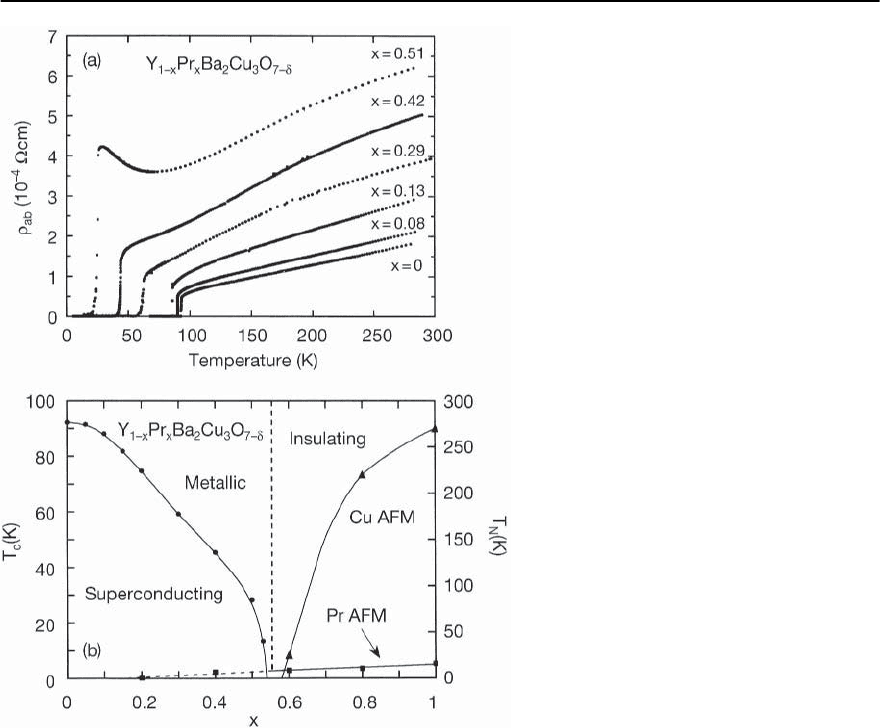
726 M.B. Maple et al.
Fig. 13.91. (a) In-plane electrical resistivity
ab
vs temperatureT curves forY
1−x
Pr
x
Ba
2
Cu
3
O
7−ı
(0 < x < 0.51) single crystals, after [282].
(b) Temperat ur e T vs Pr concentration x phase
diagram for the Y
1−x
Pr
x
Ba
2
Cu
3
O
7−ı
system,de-
lineating metallic, superconducting, insulating,
and antiferromagnetically ordered regions, af-
ter [282,596]
imum value of T
c
occurring at an optimal dopant
concentration x
0
[594]. (Note that the terminology
“under-doped” refers to values of x smaller than the
“optimally-doped” value x
0
where T
c
is maximized,
whereas“over-doped”refers to values of x larger than
x
0
.) The isotope effect on T
c
for optimally-dopedma-
terial is material is essentially zero (i.e., T
c
∝ M
−˛
with ˛ ≈ 0; M = ion mass) [595].
An interesting example of the inverted parabolic
dependence of T
c
on carrier concentration is pro-
vided by theY
1−x−y
Ca
y
Pr
x
Ba
2
Cu
3
O
7−ı
system. In this
system, the Ca
2+
and Pr ions that are substituted
for Y
3+
in YBa
2
Cu
3
O
7−ı
have the effect of “counter-
doping” the CuO
2
planes with holes and electrons,
respectively.Assuming that each substituted Ca
2+
ion
generates one hole in the CuO
2
planes,analysis of the
T
c
(x, y) data in terms of a phenomenological model
described below indicates that each substituted Pr
ion localizes approximately one hole in the CuO
2
planes [597] (see below). The localization of holes
is also reflected in the behavior of T
c
as a function of
Pr concentration x in theY
1−x
Pr
x
Ba
2
Cu
3
O
7−ı
system
(y = 0) Here, T
c
decreases with increasing x as the
Y
1−x
Pr
x
Ba
2
Cu
3
O
7−ı
system becomes more under-
doped and vanishes near the onset of the metal-
insulator transition at x
mi
≈ 0.55. The T − x phase
diagram for the Y
1−x
Pr
x
Ba
2
Cu
3
O
7−ı
system is dis-
played in Fig. 13.91(b) which shows the behavior of
T
c
(x)aswellastheN´eel temperatures T
N
(x)forAFM
ordering of Cu and Pr magnetic moments [282,596].
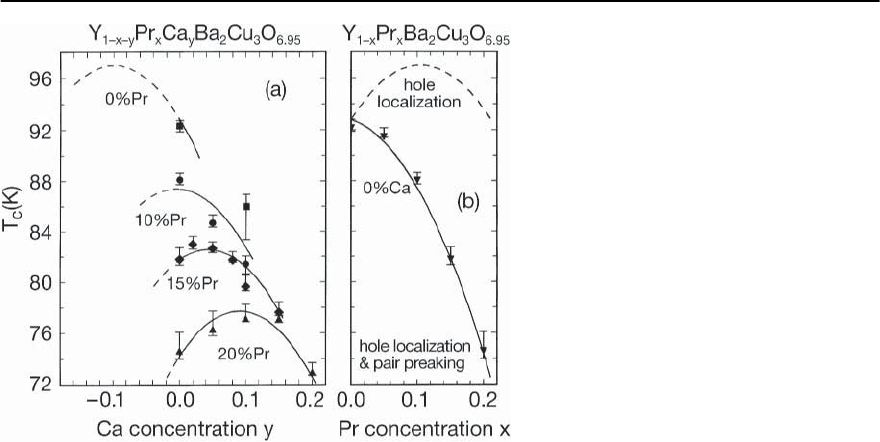
13 Unconventional Superconductivity in Novel Materials 727
Fig. 13.92. (a) Superconducting critical temper-
ature T
c
vs Ca concentration y forfourPrcon-
centrations x in the Y
1−x−y
Ca
y
Pr
x
Ba
2
Cu
3
O
7−ı
system [597]. Curves formed by solid and
dashed lines represent Eq. (13.28), as explained
in the text. (b) T
c
vs Pr concentration x.The
dashed line represents the function T
c
(x, y =
0) + (96.5K)x,whichdescribespureholelocal-
ization, and the solid line represents the func-
tion T
c
(x, y = 0), which includes hole localiza-
tion and pair-breaking, after [282,597]
It has been argued that the depression of T
c
with x
is primarily due to the decrease in the number of
mobile holes with increasing Pr concentration, al-
though magnetic pair breaking by Pr may also be
involved [596,597] (see below). Shown in Fig. 13.92
(a) are plots of T
c
vs Ca concentration y for four Pr
concentrationsx intheY
1−x−y
Ca
y
Pr
x
Ba
2
Cu
3
O
7−ı
sys-
tem [597]. Curves formed by solid and dashed lines
represent the equation
T
c
(x, y)=T
c0
− A(a − bx + y)
2
− Bx
= T
c
(97 K) − (425 K)(0.1−0.95x + y)
2
−(96.5K)x. (13.28)
The first term is the maximum attainable value of
T
c
(97 K),the second term represents the effect of hole
generation by Ca (y) ions and localization of holes
by Pr (x)ions(0.1 is an optimal hole concentration),
while the last term describes the overall depression of
T
c
with x due to pair breaking interactions in the lin-
ear low concentration regime. These data illustrate
the inverted parabolic dependence of T
c
on charge
carrier concentration observed in many supercon-
ducting cuprate systems. Displayed in Fig. 13.92(b)
is a plot of T
c
vs Pr concentration x.Thedashedline
represents the function T
c
(x, y = 0)+(96.5K)x which
corresponds to purehole localization,whilethe solid
line corresponds to the function T
c
(x, y =0)which
includes hole localization and pair breaking.
The occurrence of appreciable hybridization be-
tween the Pr localized 4f electron states and the
valence band states associated with the conducting
CuO
2
planes was first proposed by Neumeier, Maple,
andTorikachvili in 1988[598]to accountfortherapid
reductionof T
c
and the striking crossoverin thepres-
sure dependence of T
c
from positive tonegative with
increasing x in the Y
1−x
Pr
x
Ba
2
Cu
3
O
7−ı
system. This
proposal was based on similar behavior exhibited by
the La
1−x
Ce
x
system described in Sect. 13.2, in which
therateofdepressionofT
c
by the Ce impurities dis-
played a strong dependence on pressure that was at-
tributed to the hybridization between the Ce local-
ized 4f states and conduction electron states [56].Di-
rect evidence for Pr localized 4f -CuO
2
valence band
hybridization was obtained from resonant photoe-
mission spectroscopy experiments (RESPES) on the
Y
1−x
Pr
x
Ba
2
Cu
3
O
7−ı
system by Kang et al. [599].
Measurements of the pressure dependence of T
c
were repeated by Maple,Paulius,andNeumeier [600]
on higher quality Y
1−x
Pr
x
Ba
2
Cu
3
O
7−ı
specimens
studied at zero pressure by Neumeier and Maple
[596].The results of these experiments are shown in
Fig. 13.93 (a) where T
c
= T
c
(P)−T
c
(0) is plotted vs
P for several values of x between 0 and 0.5 [600].The

728 M.B. Maple et al.
T
c
(P) data are in qualitative agreement with the ear-
lier results and reveal a dramatic crossover from pos-
itive to large negative dependences of T
c
on P as the
Pr concentration is increased. Earlier measurements
of (T, P)onasamplewithx = 0.5 [596,601]showed
that this sample near the metal-insulator transition
becomes less metallic under pressure.
An extension of the formula for T
c
(x) for the
Y
1−x
Pr
x
Ba
2
Cu
3
O
7−ı
system to incorporate the effect
of applied pressure can also account semiquantita-
tively for the remarkable variations in T
c
with P that
have been observed in the Y
1−x
Pr
x
Ba
2
Cu
3
O
7−ı
sys-
tem. The trends in the T
c
(x, P)datacanbeobtained
by assuming that the parameters A and a are, to first
approximation,independent of P,andthatT
c0
, b and
B can be expanded in a power series to first order
in P; i.e.,
T
c0
(P) ≈ T
c0
(0) + T
c0
(0)P (13.29)
b(P) ≈ b(0) + b
(0)P (13.30)
B(P) ≈ B(0) + B
(0)P (13.31)
The best overall fit of the resultant expression for
[dT
c
(x, P)/dP]
P =0
to the experimentaldata yieldsthe
values T
c0
(0) = 0.048 K/kbar, b
(0) = 0.0041 K/kbar
and B
(0) = −0.02 K/kbar [600]. The increase of b
with P is consistent with an increase of the valence
(decrease in the 4f electron shell occupation num-
ber) of Pr with P, which is intuitively reasonable. A
decrease (increase) of the magnitude of the exchange
interactionparameter J with P can be inferredfrom
thedecreaseofB
(0) withP,depending upon whether
the complications associated with the Kondo effect
are excluded (included). As discussed in Sect. 13.2,
the Kondo effect is expected (and possibly observed
in the specific heat [602]) in metals containing R ions
that carry magnetic moments when there is strong
hybridizationbetween the localized 4f states of the R
ion and conduction electron states which generates
a large, negative (antiferromagnetic) exchange inter-
action [6]. However, inclusion of the Kondo effect
in the analysis of the T
c
(x, P) data is complicated.
The calculated T
c
(x, P) curves for x values corre-
sponding to the experimental T
c
(x, P) data pre-
sented in Fig. 13.93(a) are shown in Fig.13.93(b)and
give a semiquantitative description of the T
c
(x, P)
data over the range 0 ≤ x ≤ 0.5, even though
the T
c
(x, P = 0) data are only described well for
0 ≤ x ≤ 0.2 (see Fig. 13.92(b)).
It is interesting that superconductivitywithvalues
of T
c
exceeding ∼40 K has only been observed in lay-
ered cuprateswhich havestrongly anisotropic,nearly
two-dimensional electronic properties. An impor-
tant issue for these materials is the nature of inter-
layer transport and the role it plays in the super-
conductivity. Reflectance R(!)measurementswith
polarized light reveal that R(!) for the electric field
E parallel to the CuO
2
planes, E CuO
2
, exhibits
a metallic response, while R(!) for E ⊥ CuO
2
re-
sembles that of ionic insulators with characteristic
phonon peaks in the far infrared. This is illustrated
in Fig. 13.94 where R vs ! data for Tl
2
Ba
2
CuO
6+x
(Tl2201) [603] are displayed. For temperatures be-
low T
c
, a sharp plasma edge at ! =37cm
−1
evolves
out of a nearly “insulating” normal state spectrum
since the supercurrents flow in all crystallographic
directions.Inan effortto explore the relationshipbe-
tween changes in the incoherent c-axis conductivity
below T
c
and the c-axis superfluid density, Basov et
al. [603] have analyzed the interlayer conductivity of
the cuprate high T
c
superconductors Tl
2
Ba
2
CuO
6+x
,
La
2−x
Sr
x
CuO
4
, and YBa
2
Cu
3
O
6.6
,allofwhichshow
incoherent interlayer response in the normal state.
The analysis reveals that the magnitude of the su-
perfluid density
s
significantly exceeds the weight
missing from the real part of the conductivity in the
frequency region comparable to the superconduct-
ing energy gap 2. This indicates that a significant
fraction of
s
is derived from mid infrared frequen-
cies. Basov et al. [603] suggest that the discrepancy
between the magnitude of
s
and the spectral weight
that is missing from the far infrared part of the con-
ductivity can be interpreted in terms of an interlayer
kinetic energy change associated with the supercon-
ductivity.
Because of their high values of T
c
, short coher-
ence lengths, long penetration depths, and large
anisotropy, the cuprate superconductors exhibit a
wealth of striking vortex phases and phenomena that
are currently being vigorously investigated (for a re-
view, see, for example, [604–608]).
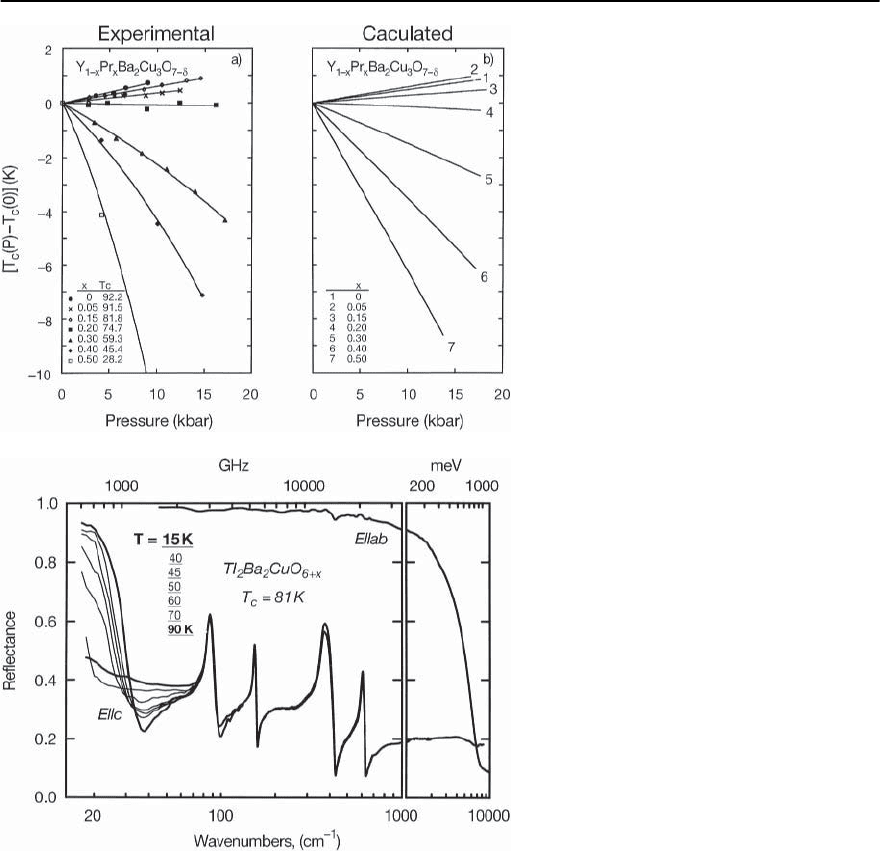
13 Unconventional Superconductivity in Novel Materials 729
Fig. 13.93. Shift in T
c
relative to its value at zero
pressure, T
c
(P)−T
c
(0), of Y
1−x
Pr
x
Ba
2
Cu
3
O
7−ı
samples with various Pr concentrations 0 ≤
x ≤ 0.5 vs pressure P to 18 kbar. (a) Experi-
mental data. (b) Calculated behavior according
to the phenomenological model described in
the text, after [600]
Fig. 13.94. Reflectance of Tl
2
Ba
2
CuO
6+x
mea-
sured with E c and E ab polarizations
of incident radiation. The c-axis reflectance is
nearly insulating in the normal state but at
T < T
c
≈ 80 K is dominated by the Josephson-
like plasma edge,after [603]
Symmetry of the Superconducting Order Parameter
A great deal of effort has been expended to de-
termine the symmetry of the superconducting or-
der parameter of the high T
c
cuprate superconduc-
tors [12, 609, 610]. The pairing symmetry provides
clues to the identity of the superconducting pairing
mechanism which is essential for the development of
the theory of high temperature superconductivity in
the cuprates.
Shortly after the discovery of high T
c
supercon-
ductivity in the cuprates, it was established from flux
quantization, Andreev reflection, Josephson effect,
and nuclear magnetic resonance (NMR) Knight-shift
measurements that the superconductivity involves
electrons that are paired in singlet spin states [611].
Possible orbital pairing states include s-wave, ex-
tended s-wave, and d-wave states. In the s-wave state,
the energy gap (k) is isotropic; i.e., (k)iscon-
stant over the Fermi surface.This leads to“activated”
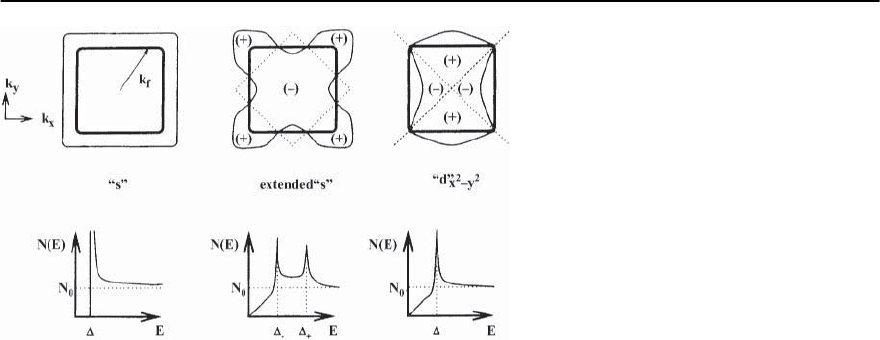
730 M.B. Maple et al.
Fig. 13.95. Fermi surface gap functions and densities of states of a superconductor with tetragonal symmetry for various
pairing symmetries. The gap functions in the k
z
=0plane(top) are represented by the light solid lines;distancefrom
the Fermi surface (dark solid lines) gives the amplitude, a positive value being outside the Fermi surface, a negative value
inside. The corresponding density of states for one-quasi-particle excitations N(E) is shown below each gap function,
with N
0
the normal state value. Gap node surfaces are represented by the dashed lines. Left: The classic s-wave case,
where the gap function is constant, with value . This gives rise to a square-root singularity in N(E)atenergyE = .
Middle: The extended s-wave case derives from pairs situated on nearest-neighbor square lattice sites in real space, with
an approximate k-space form of cos(k
x
a)−cos(k
y
a). For the Fermi surface shown here, the gap function has lines of
nodes running out of the page. Right:Ad-wave function of x
2
− y
2
symmetry.The extended s-wave and d-wave functions
shownhereeachhavealineardensityofstatesuptoorder, which measures the maximum gap amplitude about the
Fermi surface, after [12]
behavior of the physical properties in the supercon-
ducting state for T ; e.g., the specific heat C
e
(T),
ultrasonic attenuation coefficient ˛
s
(T), and NMR
spin lattice relaxation rate 1/T
1
(T)varyase
−/T
.For
the extended s-wave state, the energy gap (T)is
anisotropic; i.e., (k) exhibits a variation over the
Fermi surface that has the same symmetry as the
rotational symmetry of the crystal. Similarly, for the
d-wave case,the energy gap (k) is anisotropic; how-
ever, the symmetry is lower than the symmetry of
the crystal. The d-wave state that is consistent with
most, but not all, of the experiments discussed be-
low has d
x
2
−y
2
symmetry, which can be expressed as
(k)=
0
[cos(k
x
a)−cos(k
y
a)]. For both the ex-
tended s-wave and d-wave cases, (k)vanishesat
lines on the Fermi surface, resulting in a density of
states N(E)thatislinearinenergyE at low values
of E. This leads to “power-law” T
n
(n = integer) be-
havior of the physical properties for T ; e.g.,
C
e
(T) ∼ T
2
, the superconducting penetration depth
(T) ∼ T,and1/T
1
(T) ∼ T
3
. The definitive de-
termination of the symmetry of the superconduct-
ing order parameter requires the determination of
both the magnitude and the phase of (k). Shown in
Fig. 13.95 is a schematic diagram of the variation of
the energy gap over the Fermi surface and the den-
sity of states N(E)vsE for the “s”,“extended s”, and
“d
x
2
−y
2
”states [12].
Magnitude of the Superconducting Order Parameter
A number of different types of measurements have
been performed on the high T
c
cuprate supercon-
ductors that are sensitive to |(k)|. These include
microwave penetration depth (T) [612],microwave
surface conductivity [613], nuclear magnetic reso-
nance (NMR) relaxation rate 1/T
1
(T) [614], mag-
netic field dependence of the electronic specific heat
C
e
(T) [615], thermal conductivity [616], angle re-
solved photoemission spectroscopy (ARPES) [617],
quasiparticle tunneling [618,619] and Raman scat-
tering [620]. The results of these studies are gen-
